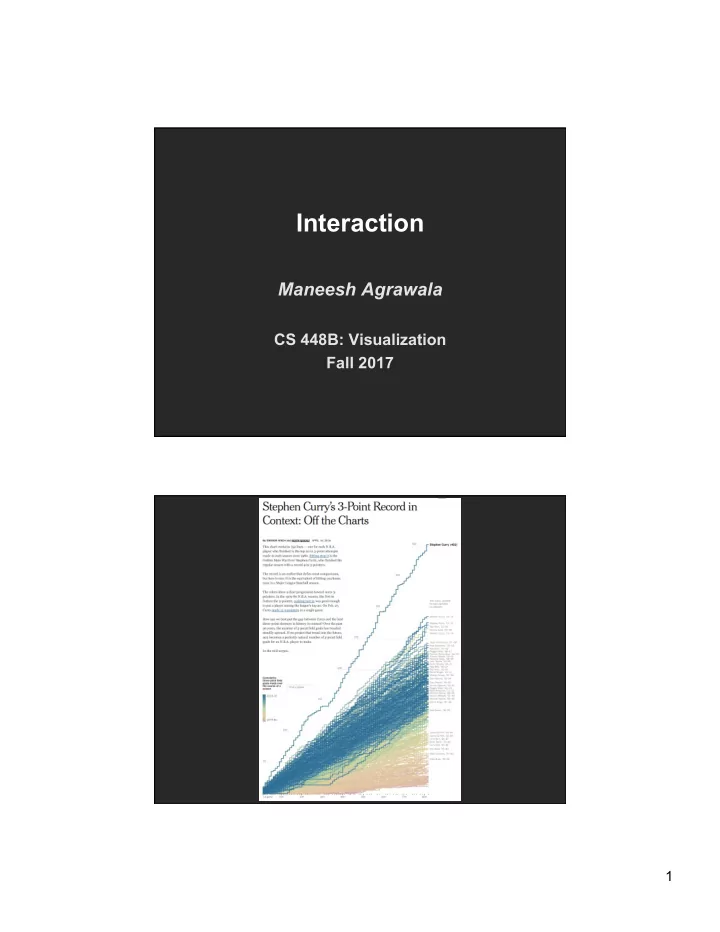

Interaction Maneesh Agrawala CS 448B: Visualization Fall 2017 1
Last Time: Perception Just noticeable difference JND (Weber ’ s Law) ■ Ratios more important than magnitude ■ Most continuous variations in stimuli are perceived in discrete steps 2
Steven ’ s power law p < 1 : underestimate p > 1 : overestimate [graph from Wilkinson 99, based on Stevens 61] Steven ’ s power law The law predicts bias: the deviation of population-averaged estimates from the true values. It doesn’t necessarily predict error ! What if length averages to the true value but most estimates exhibit high deviation? [graph from Wilkinson 99, based on Stevens 61] 3
[Cleveland and McGill 84] [Cleveland and McGill 84] 4
Relative magnitude estimation Most accurate Position (common) scale Position (non-aligned) scale Length Slope Angle Area Volume Least accurate Color hue-saturation-density Gestalt 5
Principles ■ figure/ground ■ proximity ■ similarity ■ symmetry ■ connectedness ■ continuity ■ closure ■ common fate ■ transparency Figure/Ground Principle of surroundedness Principle of relative size Ambiguous http://www.aber.ac.uk/media/Modules/MC10220/visper06.html 6
Figure/Ground Ambiguous Unambiguous http://www.aber.ac.uk/media/Modules/MC10220/visper06.html Proximity [Ware 00] 7
Similarity Rows dominate due to similarity [from Ware 04] Symmetry Bilateral symmetry gives strong sense of figure [from Ware 04] 8
Connectedness Connectedness overrules proximity, size, color shape [from Ware 04] Continuity We prefer smooth not abrupt changes [from Ware 04] Connections are clearer with smooth contours [from Ware 04] 9
Continuity: Vector fields Prefer field that shows smooth continuous contours [from Ware 04] Closure We see a circle behind a rectangle, not a broken circle [from Ware 04] Illusory contours [from Durand 02] 10
Common fate Dots moving together are grouped http://coe.sdsu.edu/eet/articles/visualperc1/start.htm Transparency Requires continuity and proper color correspondence [from Ware 04] 11
Layering and Small Multiples Layering: Gridlines Electrocardiogram tracelines [from Tufte 90] 12
Layering: Gridlines Stravinsky score [from Tufte 90] Setting Gridline Contrast How light can gridlines be and remain visible? How dark can gridlines be and not distract? Safe setting: 20% Alpha [Stone & Bartram 2009] 13
Layering: Color and line width IBM Series III Copier [from Tufte 90] Small multiples [Figure 2.11, p. 38, MacEachren 95] 14
Small multiples Operating trains. Redrawn by Tufte to emphasize colored lights. [fromTufte 90] Change blindness [Example from Palmer 99, originally due to Rock] 15
Change detection Change detection 16
Rensink ’ s demonstration http://www.csc.ncsu.edu/faculty/healey/PP/index.html Summary Choosing effective visual encodings requires knowledge of visual perception Visual features/attributes ■ Individual attributes often preattentive ■ Multiple attributes may be separable, often integral Gestalt principles provide higher level design guidelines We don ’ t always see everything that is there 17
Announcements Assignment 2: Exploratory Data Analysis Use Tableau to formulate & answer questions First steps ■ Step 1: Pick a domain ■ Step 2: Pose questions ■ Step 3: Find data ■ Iterate Create visualizations ■ Interact with data ■ Question will evolve ■ Tableau Make notebook ■ Keep record of all steps you took to answer the questions Due before class on Oct 16, 2017 18
Interaction Gulfs of execution & evaluation Gulfs Evaluation Conceptual model Real world Execution [Norman 1986] 19
Gulf of Execution The difference between the user ’ s intentions and the allowable actions. Gulf of Evaluation The amount of effort that the person must exert to interpret the state of the system and to determine how well the expectations and intentions have been met. [Norman 1986] Gulf of evaluation Gulf Real world: Evaluation X Y 0.67 0.79 0.32 0.63 0.39 0.72 0.27 0.85 Conceptual model: 0.71 0.43 0.63 0.09 0.03 0.03 x,y correlated? 0.20 0.54 0.51 0.38 0.11 0.33 0.46 0.46 20
Gulf of evaluation Gulf Real world: Evaluation 1 Y 0.5 Conceptual model: x,y correlated? 0 0 0.5 1 X Gulf of evaluation Gulf Real world: Evaluation ρ = -.29 Conceptual model: x,y correlated? 21
Gulf of execution Gulf 1 Conceptual model: Y 0.5 Draw a scatterplot 0 0 0.5 1 X Real world Move 90 30 Rotate 35 Execution Pen down … Gulf of execution Gulf 1 Conceptual model: Y 0.5 Draw a scatterplot 0 0 0.5 1 X Real world Execution 22
Topics Early interactive systems Brushing and linking Dynamic queries Generalized selections Early Systems 23
[Graphics and Graphic Information Processing, Bertin 81] Bertin Matrices Research question Table 1. Encode table cells visually 2. Group similar rows and columns to reveal patterns 24
[Graphics and Graphic Information Processing, Bertin 81] Group similar rows and columns Choose a row with a particular visual aspect. Move to extremity of matrix. Move similar rows close, opposite rows to bottom. (Creates two opposing groups and a middle group) Repeat for columns Iterate 25
[Graphics and Graphic Information Processing, Bertin 81] [Graphics and Graphic Information Processing, Bertin 81] 26
[Graphics and Graphic Information Processing, Bertin 81] [Graphics and Graphic Information Processing, Bertin 81] 27
Bertifier [Perin 2014] Bertifier [Perin 2014] 28
Visual encodings Quantity of ink is proportional to the normalized data value 29
Reordering methods Manual Automatic bertifier.com PRIM-9, Tukey, Fisherkeller, Friedman 1972 30
31
Pointing Basic Pointing Methods Point Selection Mouse Hover / Click Touch / Tap Select Nearby Element (e.g., Bubble Cursor) 32
33
Basic Pointing Methods Point Selection Mouse Hover / Click Touch / Tap Select Nearby Element (e.g., Bubble Cursor) Region Selection Rubber-band or Lasso Area Cursors (“Brushes”) 34
Brushing and Linking Highlighting Focus user attention on a subset of the data within one graph [from Wills 95] 35
Brushing ■ Interactively select subset of data ■ See selected data in other views ■ Two things (normally views) must be linked to allow for brushing Brushing Scatterplots Brushing Scatterplots, Becker & Cleveland 1982 36
Baseball statistics [from Wills 95] how long select high in majors salaries avg career avg assists vs HRs vs avg avg putouts career hits (fielding ability) (batting ability) distribution of positions played Linking assists to positions 37
GGobi: Brushing http://www.ggobi.org/ 38
Recommend
More recommend